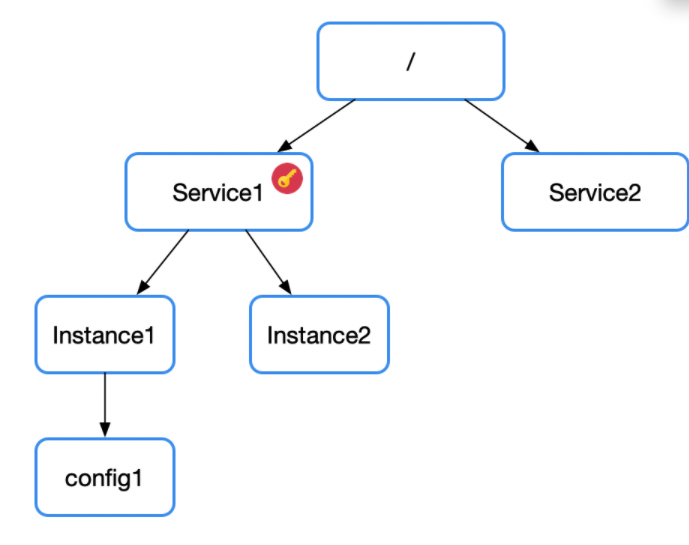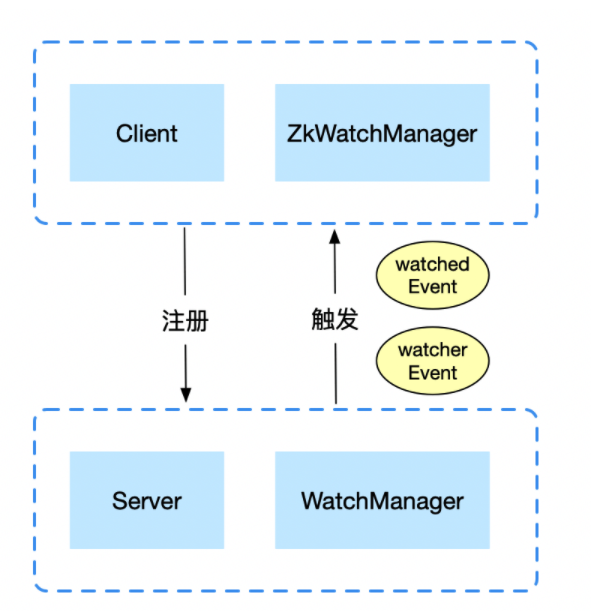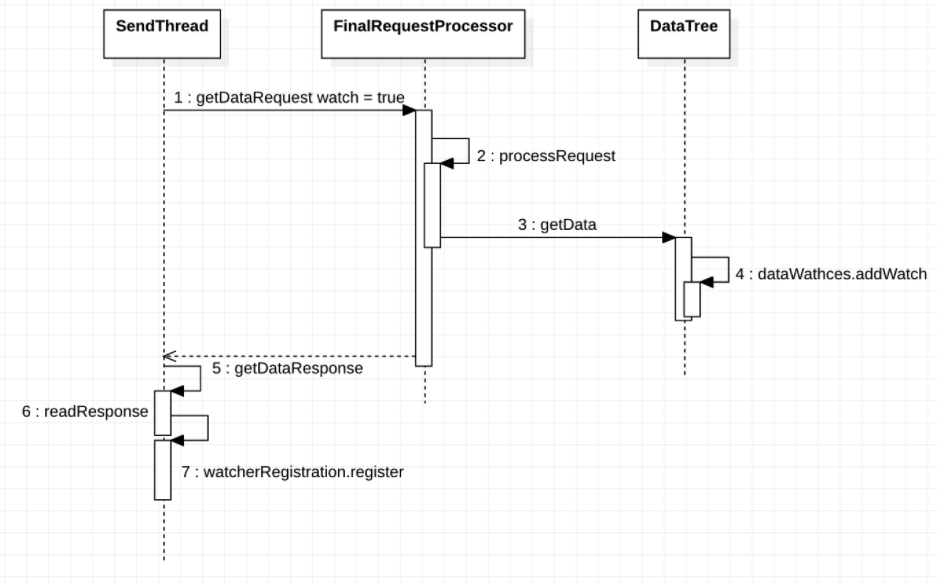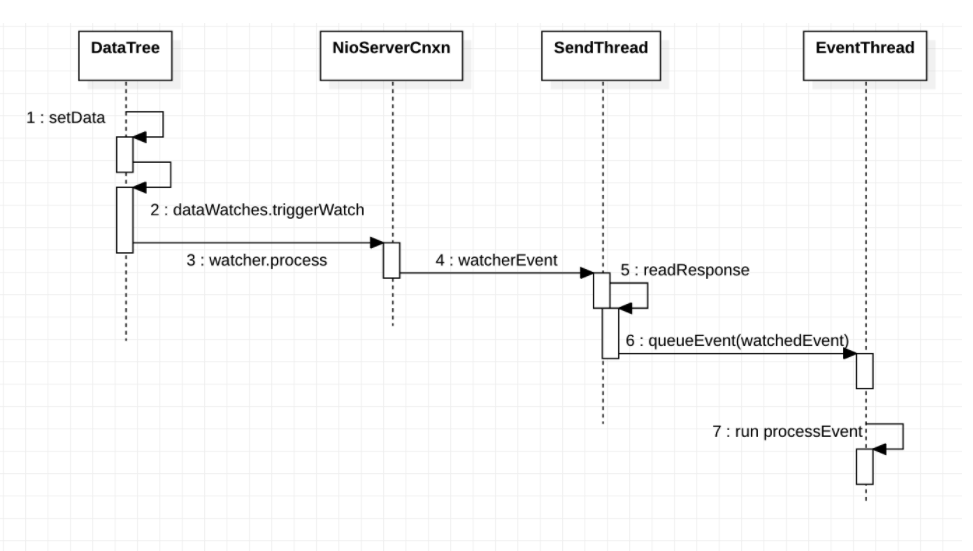我们可以使用 zookeeper 作为注册中心来实现服务的注册与发现,curator 框架提供了 curator-x-discovery 扩展实现了开箱即用的服务注册发现,但更多时候我们还是选择自己去实现,那这个时候我们需要额外关注 zookeeper 的 1 个特性,即 wathcer。
在微服务场景中,watcher 机制主要提供了服务通知功能,比如 Instance1 这个实例在 Service1 服务节点下注册了一个 emphemeral 子节点后,它的某个服务消费者根据依赖配置在 Service1 节点上注册了一个子节点 watcher,就如图中的红钥匙。
子节点类型的 watcher 会观测 Service1 的子节点,即 InstanceX 节点,但不会观测孙子节点 config1。那么当 Instance1 节点挂掉之后,watcher 可以做到通知给注册自身的那个服务消费者,通知完一次后 wacther 也就被销毁了。
wacther 原理框架
zookeeper 的 watcher 主要由 client、server 以及 watchManager 之间配合完成,包括 watcher 注册以及触发 2 个阶段。
在 client 端注册表为 ZkWatchManager,其中包括了 dataWatches、existWatches 以及 childWatches。在 server 端的注册表在 DataTree 类中,封装了 2 类 WatchManager,即 dataWatches 和 existWatches。dataWatches 代表当前节点的数据监听,childWathes 代表子节点监听,与 client 比少的 existWatches 也很容易理解,因为节点是否存在需要客户端去判断。
注册阶段客户端的 getData 和 exists 请求可以注册 dataWatches,getChilden 可以注册 childWatches。而触发阶段,setData 请求会触发当前节点 dataWatches,create 请求会触发当前节点 dataWatches 以及父节点的 childWatches,delete 请求则会触发当前节点、父节点、子节点的 dataWatches,以及父节点的 childWatches。
watchManager包含两个非常重要的数据结构:watchTable和watch2Paths。前者表示path-set ,后者表示watcher-set 。注意这里的watcher含义表示远程连接,所以watchTable表示一个目录下可能有多个消费者的监听连接,而watch2Paths表示一个消费者可能会对多个目录建立监听,显然多目录的监听会复用一个连接。
请求阶段的传输数据(包括 watcher 信息)会封装在 request 和 response 中,比如 getData 请求会封装 getDataRequest/getDataResponse。而触发阶段的 watcher 通知则通过事件 event 进行通信,server 端会发送一个 watcherEvent,而 client 端则会将其转换成 watchedEvent 再进行处理。
每个客户端都会维护 2 个线程,SendThread 负责处理客户端与服务端的请求通信,比如发送 getDataRequest,而 EventThread 则负责处理服务端的事件通知,即 watcher 的事件。
watcher 注册源码
我们来看看 watcher 注册的部分源码。首先是在客户端,以 Zookeeper 中 getData 方法为例,会入队一个 watch 为 true 的 packet。
public byte[] getData(final String path, Watcher watcher, Stat stat) throws KeeperException, InterruptedException { ... GetDataRequest request = new GetDataRequest(); request.setPath(serverPath); request.setWatch(watcher != null); GetDataResponse response = new GetDataResponse(); ReplyHeader r = cnxn.submitRequest(h, request, response, wcb); ... }
可以看到这边封装了 GetDataRequest 以及 GetDataResponse,而 request 中设置了 watch 参数为 true,最后将其进行 submitRequest,submitRequest 干的事儿其实就是将这些放入事件队列等待 sendThread 调度发送。
接着这个请求会被服务端所接收到,所有请求的服务端处理都在 FinalRequestProcessor#processRequest 方法中进行。
case OpCode.getData: { lastOp = "GETD"; GetDataRequest getDataRequest = new GetDataRequest(); ... byte b[] = zks.getZKDatabase().getData(getDataRequest.getPath(), stat, getDataRequest.getWatch() ? cnxn : null); ... }
这边会通过一些 case 来判断请求类型,还是以 getData 为例,最终会调用到 DataTree 的 getData 方法,我们之前讲到 DataTree 里包含了 2 种 watcher,那这边除了获取数据外,自然是注册 dataWatchers 了。
public byte[] getData(String path, Stat stat, Watcher watcher) throws NoNodeException { DataNode n = (DataNode)this.nodes.get(path); if (n == null) { throw new NoNodeException(); } else { synchronized(n) { n.copyStat(stat); if (watcher != null) { this.dataWatches.addWatch(path, watcher); } return n.data; } } }
addWatch 方法主要是将数据节点的路径以及 ServerCnxn(远程通信信息) 信息存储到 WatchManager 的 watchTable 和 watch2Paths 中。至此服务端已经接受到了 watcher 并注册到了 watchManager 中了。
我们将客户端自己也会保存一个 watchManager,这里其实是在接收到 getData 响应后进行的,在 ClientCnxn$SendThread 类的 readResponse->finishPacket 方法中。
private void finishPacket(ClientCnxn.Packet p) { if (p.watchRegistration != null) { p.watchRegistration.register(p.replyHeader.getErr()); } if (p.cb == null) { synchronized(p) { p.finished = true; p.notifyAll(); } } else { p.finished = true; this.eventThread.queuePacket(p); } }
可以看到这边调用了 watchRegistration 的 register 方法,而它就是根据请求类型来装入对应的 watchManager 中了(dataWatches、existWatches、childWatches)。
整个大致的时序图可以参考下面:
watcher 触发源码
wathcer 触发部分,我们还以 服务端 DataTree 类处理 setData 请求 为例。
public Stat setData(String path, byte data[], int version, long zxid, long time) throws KeeperException.NoNodeException { ... dataWatches.triggerWatch(path, EventType.NodeDataChanged); return s; }
可以看到在处理完数据后调用了 triggerWatch,它干的事儿是从之前的 watchManager 中获得 watchers,然后一个个调用 process 方法。
public Set<Watcher> triggerWatch(String path, EventType type, Set<Watcher> supress) { WatchedEvent e = new WatchedEvent(type, KeeperState.SyncConnected, path); HashSet<Watcher> watchers; synchronized (this) { watchers = watchTable.remove(path); if (watchers == null || watchers.isEmpty()) { if (LOG.isTraceEnabled()) { ZooTrace.logTraceMessage(LOG, ZooTrace.EVENT_DELIVERY_TRACE_MASK, "No watchers for " + path); } return null; } for (Watcher w : watchers) { HashSet<String> paths = watch2Paths.get(w); if (paths != null) { paths.remove(path); } } } for (Watcher w : watchers) { if (supress != null && supress.contains(w)) { continue; } w.process(e); } return watchers; }
获取了需要本次触发的监听后,在 watchTable 和 watch2Paths 中还移除了自身,所以 watcher 是单次的。这里封装好了 watchedEvent 后塞入到了 Watcher的process 方法中,process 方法其实就是发送通知,以 Watcher的一个实现类NioServerCnxn 为例就是调用了其 sendResponse 方法将通知事件发送到客户端,发送前会将 watchedEvent 转换成 watcherEvent 进行发送。
那么客户端首先接收到请求的仍然是 ClientCnxn$sendThread 的 readResponse 方法,这里讲 watcherEvent 转换为 watchedEvent 后入列 eventThread 的事件队列 等待后续进行处理。
... WatchedEvent we = new WatchedEvent(event); if (ClientCnxn.LOG.isDebugEnabled()) { ClientCnxn.LOG.debug("Got " + we + " for sessionid 0x" + Long.toHexString(ClientCnxn.this.sessionId)); } ClientCnxn.this.eventThread.queueEvent(we); ...
我们直接看下 EventThread 的 run 方法吧,方法很简单,就是不断从 waitingEvents 事件队列中取通知事件。然后调用 processEvent 方法处理事件。
private void processEvent(Object event) { try { if (event instanceof WatcherSetEventPair) { // each watcher will process the event WatcherSetEventPair pair = (WatcherSetEventPair) event; for (Watcher watcher : pair.watchers) { try { watcher.process(pair.event); } catch (Throwable t) { LOG.error("Error while calling watcher ", t); } } } else { ...省略 }
这里就是简单地取出本次事件需要通知的 watcher 集合,然后循环调用每个 watcher 的 process 方法了。那么在自己实现服务注册发现的场景里,显然 watcher 的 process 方法是我们自定义的啦。
整个 watcher 触发的时序图可以参考下面:
至此,zookeeper 的整个 watcher 交互逻辑就已经结束了。




